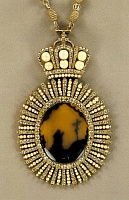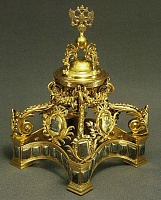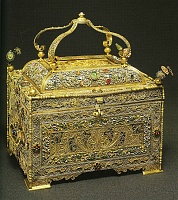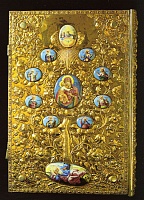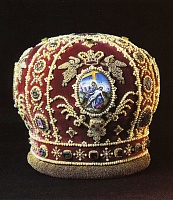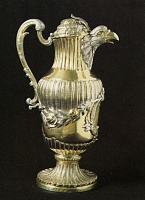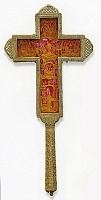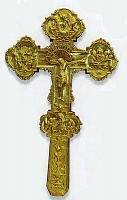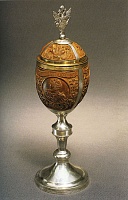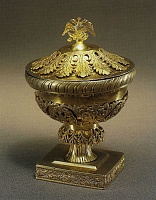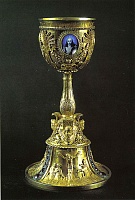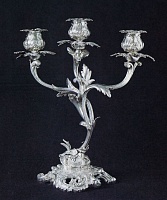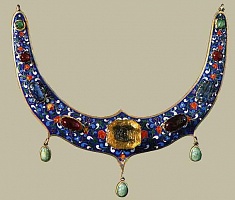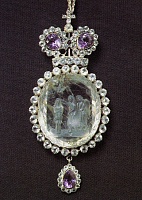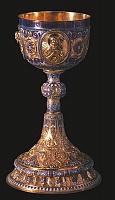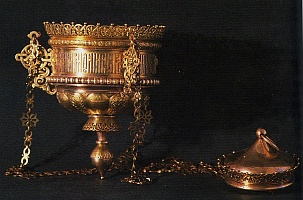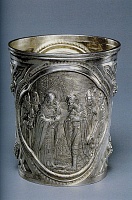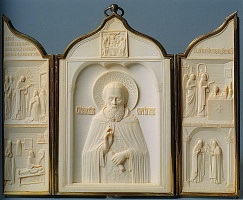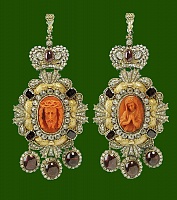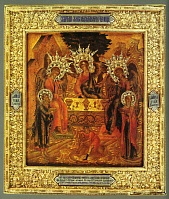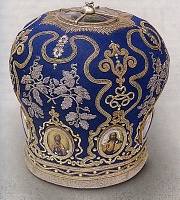Jewelry Art of the 18th – 19th centuries
Catherine II granted Archbishop Platon with the dignity of Metropolitan of Moscow and Koluga for his 50th birthday and the Trinity authorities marked the event presenting him a panagia with the engraved date and initials “PMM” on the reverse. The Byzantine cameo of the 12th century from the Monastery treasures was used as the central part of the panagia. The ancient cameo was framed in a gold filigree pattern and colored stones – the materials and technique, greatly appreciated in the vanished Byzantine culture. The interest in rare stones is reflected in the diamond panagia – a personal property of the Moscow Metropolitan.
A number of items from the 18th century Monastery collection belonged to Metropolitan Platon of Moscow and Kolomna. Some of them were presented to him by Empress Catherine II. The salt-cellar (Incense-box), made by A.I. Ratkov was one of her gifts. The reliquary of mysterious origin was made like a casket and subsequently readjusted for the new function. The only analogy is preserved in Pavlovsk Palace that used to be Maria Feodorovna’s residence.
The precious article could have been a personal present of Empress who paid him respect more than once. Whatever the origin of the casket was, it is quite a “royal” object, decorated with intricate filigree, enamel and precious stones. The chalice of an unusual shape and material from the Museum collection was made of plumbic cut glass and decorated with gilding, chasing and engraving.
In the 18th century, chasing remained a traditional technique in decoration of book covers, icon mountings, liturgical and secular vessels. The large Gospel of 1689, was decorated with most complicated gilded cover in 1754. It is embellished with numerous chased baroque cartouches. This cover was produced by a silversmith and enameller of the Trinity-St. Sergius Lavra.
The enameled plaques with the series of Passions, made by the same craftsman, are included in the system of decoration of the mid-18th century mitre and chalice of 1788. Several splendid precious works are connected with the names of famous Moscow and St. Petersburg silversmiths G.I. Serebryannikov, P.T. Vorobei, K.I. Elers, A.I. Ratkov. Various materials and techniques were used. The mitre of 1788, for example, was made of velvet and decorated with pearls, precious stones, silver, gold, spun gold, embroidery, stringing, chasing, carving, cutting, painted enamel.
In 1768 and in 1769 a famous court master K.I. Elers made a silver plate with the scene “The Miracle of Iona” and a silver jug with the head of an eagle on the lid. G.I. Serebryannikov used baroque shapes in the gilded cover of 1741 for the early 18th century Gospel. The whole surface of the obverse was covered with a thick floral pattern. The cover of the small Pontifical Service Book, donated by Metropolitan Platon in 1789, is decorated with a light refine filigree pattern of interweaving sprouts and flowers.
The Museum collection comprises various liturgical crosses of different size and shape. One of the best specimens of “prayer” or “blessing” crosses belonged to Metropolitan Platon Levshin. The christcross with an attachable handle is carved in wood in rococo style and framed in a silver filigree case. The liturgical cross with eight ends, donated to the Trinity-St. Sergius Lavra by widowed landlady Ivanovskaya, was regilded and fixed on the silver crosier of Metropolitan Filaret in the 19th century.
The goblet, made by a Moscow craftsman, has numerous analogues in European art. It is made of coconut, framed in silver and decorated with gilding, chasing and carving. The remarkable holy water basin (used as a tureen) was made by P.T. Vorobei. The elaborate baroque or more balanced ornamental compositions, combination of gilded and white silver and fine chasing are characteristic of many 18th century works.
Among the royal presents of the 19th century there is the salt-cellar, donated “to the coffin of St. Sergius” by Grand Princess Elena Pavlovna in 1833. Enameled plaques in combination with strasses and precious stones were traditional decorations of silver church vessels. They were used in the chalice decorated with chasing in high relief and sculptural casting that was made by E.A. Antipiev.
In the Lavra archive documents a group of royal donations was recorded. It included a number of gold icon-lamps, precious chalices and a luxurious topaz cross “covered with two rows of diamond sparkles”. Most beautiful were coronation presents of Emperor Alexander II and Empress Maria Feodorovna. The fancy candlestick, made in 1856 by I. Nordberg, is distinguished by elaborate chasing.
Precious and semi-precious stones were used in a various crosses and panagias. The special hall at the exposition houses precious articles of liturgical service connected with Father Superior of the Trinity-St. Sergius Lavra (1821 – 1867) Filaret Drozdov, Metropolitan of Moscow. Eclecticism was a synonym of the 19th century culture. Filaret’s long ministry coincided with the social interest in national roots. In church art “Russian style” prevailed.
The first stage of Russian style (1830 – 1860) was called Russian Byzantine or archeological style. The so-called Korsun cross is referred to the archeological trend. It belonged to Archimandrite Antony Medvedev, the vicegerent of the Trinity-St. Sergius Lavra. The crescent collar with the late 16th century cameo belongs to the same style. Historical romanticism called into existence such a phenomenon as reconstruction of ancient rarities.
In the late 1860s “the folklore” trend was considerably promoted by the peasant reform. The precious reliquaries, shaped like wooden churches, were quite characteristic works of the 19th century. Works in Russian style were also produced for memorable dates. Thus, in 1867, the citizens of Moscow presented a salt-cellar to Metropolitan Filaret to mark 50 years of his archbishop service.
Striving for national decorativeness was reflected with special emphasis in numerous enamel utensils. The ancient techniques of cell enamel, chamfer enamel, painted enamel, enamel on relief and filigree patterns were frequently used again. Thus, the chalice of the last three decades of the 19th century is a good example of enamel. The gold icon-lamp of 1892 was presented by the citizens of Sergiev Posad “for the tomb of St. Sergius” to mark 500 years of his commemoration. Its decoration imitated pierced wood work that was considered very stylish. Gradually the Russian trend was replaced by modern style. Soft overflowing colors splendidly corresponded to the plastic modern ornaments. The collection also includes silver vessels, tumblers in particular, made by the Trinity silversmiths for Сouncil tabless. The tumbler, made in 1880, is decorated with beautiful engraving and chasing. The verses, engraved on the tumbler, run:
Entire Holy Russia trembles because of Mamai/ Prince himself hurries/ For the blessing of Sergius/ His brow shows trouble/Don’t you worry said the elder/ You will win. Believe it
The church objects of the 19th century are richly decorated with enamel and precious stones. At that time multicolored schemes were most significant elements of national art. The altar cross, made in Perm in 1891, is impressively decorated with numerous shining stones: violet amethysts, yellowish topazes, transparent rock crystal, red and green garnets. Among the 19th century precious works one should mark the pontifical panagia, donated by Moscow Metropolitan Filaret to the Trinity-St. Sergius Lavra. It is a superb work of jewelry art.
The folding icon with the image of St. Sergius of Radonezh was carved in bone and framed in silver by monk Iona (Ivan Iljin). In 1867, it was sent to the World Exhibition in Paris and returned with the honorary approval.
The Sacristy presents personal belongings of Filaret (Drozdov), the Trinity-St. Sergius Lavra Father Superior, Metropolitan of Moscow and Kolomna buried in the Monastery and canonized in 1994. Two icons, painted in M.D. Shein workshops, are decorated with gilded silver mountings. The gold panagia is decorated with pearls, turquoise, almandines, emeralds and diamonds. Chasing, cutting and painted enamel on the chalice prove the craftsmen’s great skill.











